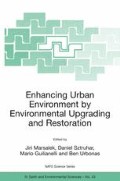4. Conclusions
Separate treatment of the nitrogen rich reject water improves the COD/N ratio in the mainstream activated sludge process and consequently improves the efficiency of the biological nitrogen removal in sewage treatment plants.
The composition of the reject water is suitable for the use of new biological processes like nitritation/denitritation.
Primary sludge can be successfully used as the carbon source for the denitritation, which can be complete and controlled by the primary sludge / reject water ratio.
Treating the reject water with the extremely low CODsoluble/N-NH +4 ratio of 0.64, without an external carbon addition (considering the primary sludge as an internal source), at the volumetric loading rate up to 0.32 kgN/m3, the average nitrogen removal efficiency above 70% was achieved.
Access this chapter
Tax calculation will be finalised at checkout
Purchases are for personal use only
Preview
Unable to display preview. Download preview PDF.
6. References
Novak L., Havrlikova D. (2003). Performance intensification of the Prague wastewater treatment plant. Proc. of 9th Conf. Design, Operation and Economics of Large Wastewater Treatment Plants, Prague 1–4 September 2003, 219–226.
Barnes L.M. (2001). The use of high-rate nitrification for the pretreatment of ammoniacal digested sludge liquors. J.CIWEM, 14, 401–408.
Laurich F., Thierbach R. (2001). Sludge liquor management with Store and Treat. Proc. of 2nd IWA World Water Congress (CD-ROM), Berlin 15–19 October.
Wett B. (2001). Stable N-elimination on the nitrate route in a full scale SBR for rejection water treatment. Proc. of 2nd IWA World Water Congress (CD-ROM), Berlin 15–19 October.
Mulder, J.W., van de Graaf, A.A., Robertson, L.A., Kuenen, J.G. (1995). Anaerobic ammonium oxidation discovered in a denitrifying fluidized bed reactor. FEMS Microbiology Ecol., 16, 177–185.
Hippen, A., Baumgarten, G., Rosenwinkel, K.H., Seyfried, C.F. (1994). Aerobic deammonification — a new experience in the treatment of wastewaters. Water. Sci. Tech., 35(10), 111–120.
Abeling, U., Seyfried, C.F. (1992). Anaerobic-aerobic treatment of high strength ammonium wastewater — nitrogen removal via nitrite. Water Sci. Tech. 26(5–6), 1007–1015.
Beier, M., Hippen, A., Seyfried, C.F., Rosenwinkel, K.H., Johansson, P. (1998). Comparison of different biological treatment methods for nitrogen-rich waste waters. European Water Management, 2,1, 61–66.
Moser-Engler, R., Udert, K.M., Wild, D., Siegrist, H. (1998). Products from primary sludge fermentation and their suitability for nutrient removal. Water Sci. Tech., 38(1), 265–273.
Wong Chong, G.M., Loehr, R.C. (1978). Kinetics of microbial nitrification: nitrite-nitrogen oxidation. Water Res., 12, 605–609.
Ford D.L., Churchwell, R.L., Kachtick, J.W. (1980). Comprehensive analysis of nitrification of chemical processing wastewater. J.Water Pollut. Control Fed., 52(11), 2726–2746.
Anthonisen, A.C., Loehr, R.C., Prakasam, T.B.S., Srinatu, E.G. (1976). Inhibition of nitrification by ammonia and nitrous acid. J.Water Pollut. Control Fed., 48, 835–852.
Jenicek, P., Svehla, P., Zabranska, J., Dohanyos, M. (2003). Factors affecting nitrogen removal by nitritation/denitritation. Proc of Int. Symp. on Strong Nitrogenous and Agro-Wastewater, 85–92, Seoul 11–13 June 2003.
Author information
Authors and Affiliations
Editor information
Editors and Affiliations
Rights and permissions
Copyright information
© 2004 Kluwer Academic Publishers
About this paper
Cite this paper
Jenicek, P. (2004). Upgrading Sewage Treatment Plants for Higher Performance by Optimising Reject Water Treatment. In: Marsalek, J., Sztruhar, D., Giulianelli, M., Urbonas, B. (eds) Enhancing Urban Environment by Environmental Upgrading and Restoration. Nato Science Series: IV: Earth and Environmental Sciences, vol 43. Springer, Dordrecht. https://doi.org/10.1007/1-4020-2694-3_16
Download citation
DOI: https://doi.org/10.1007/1-4020-2694-3_16
Publisher Name: Springer, Dordrecht
Print ISBN: 978-1-4020-2692-8
Online ISBN: 978-1-4020-2694-2
eBook Packages: Earth and Environmental ScienceEarth and Environmental Science (R0)

